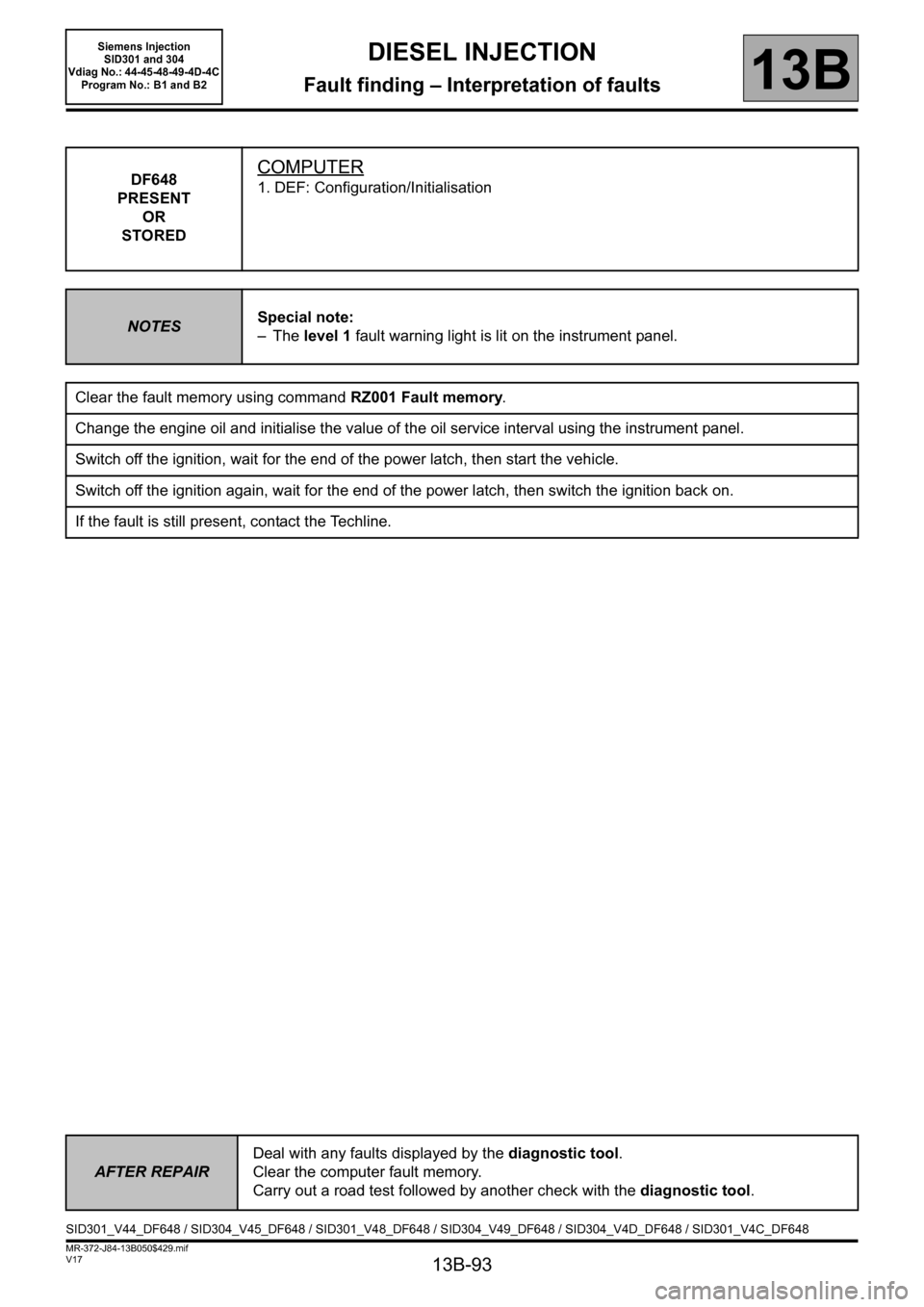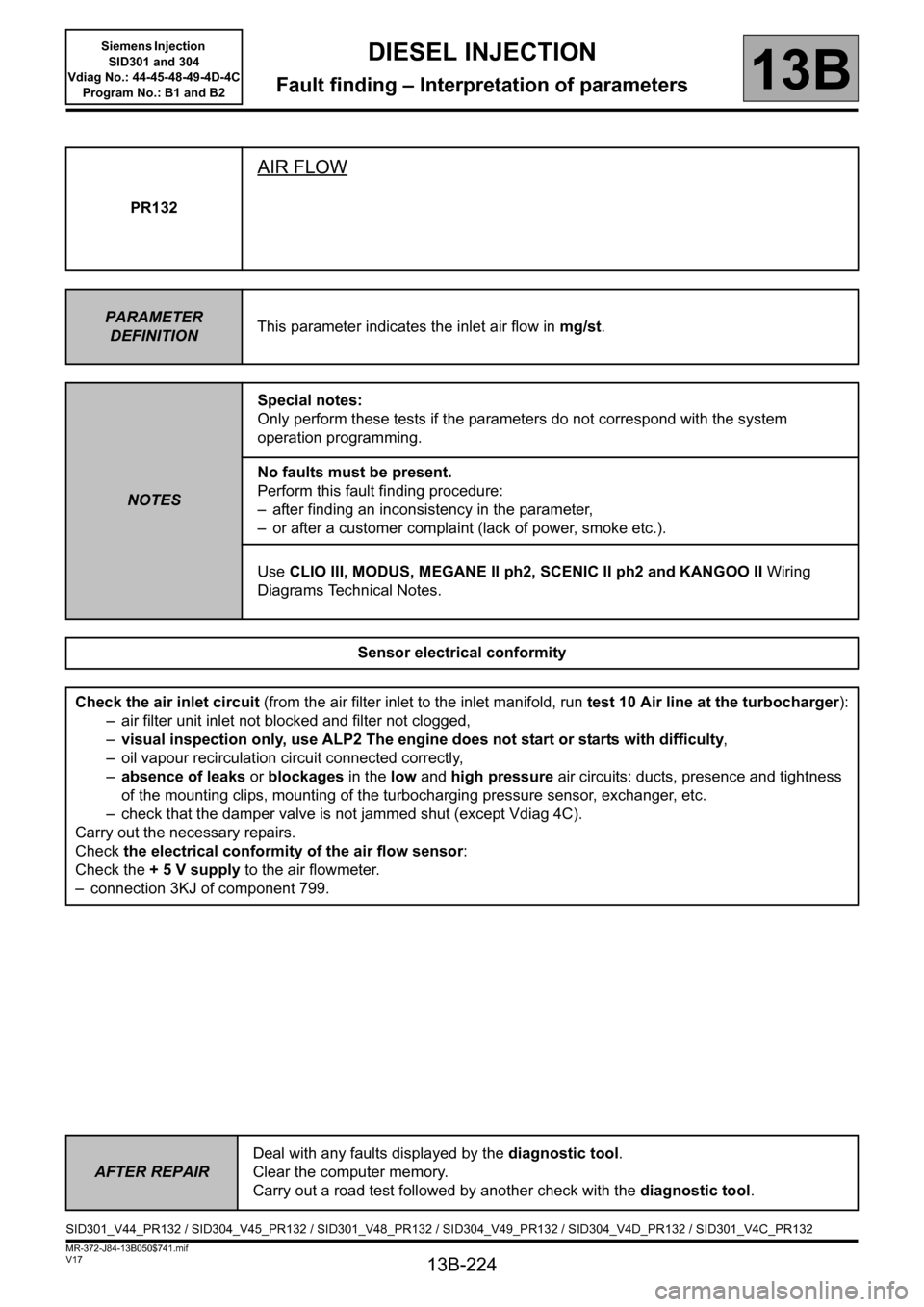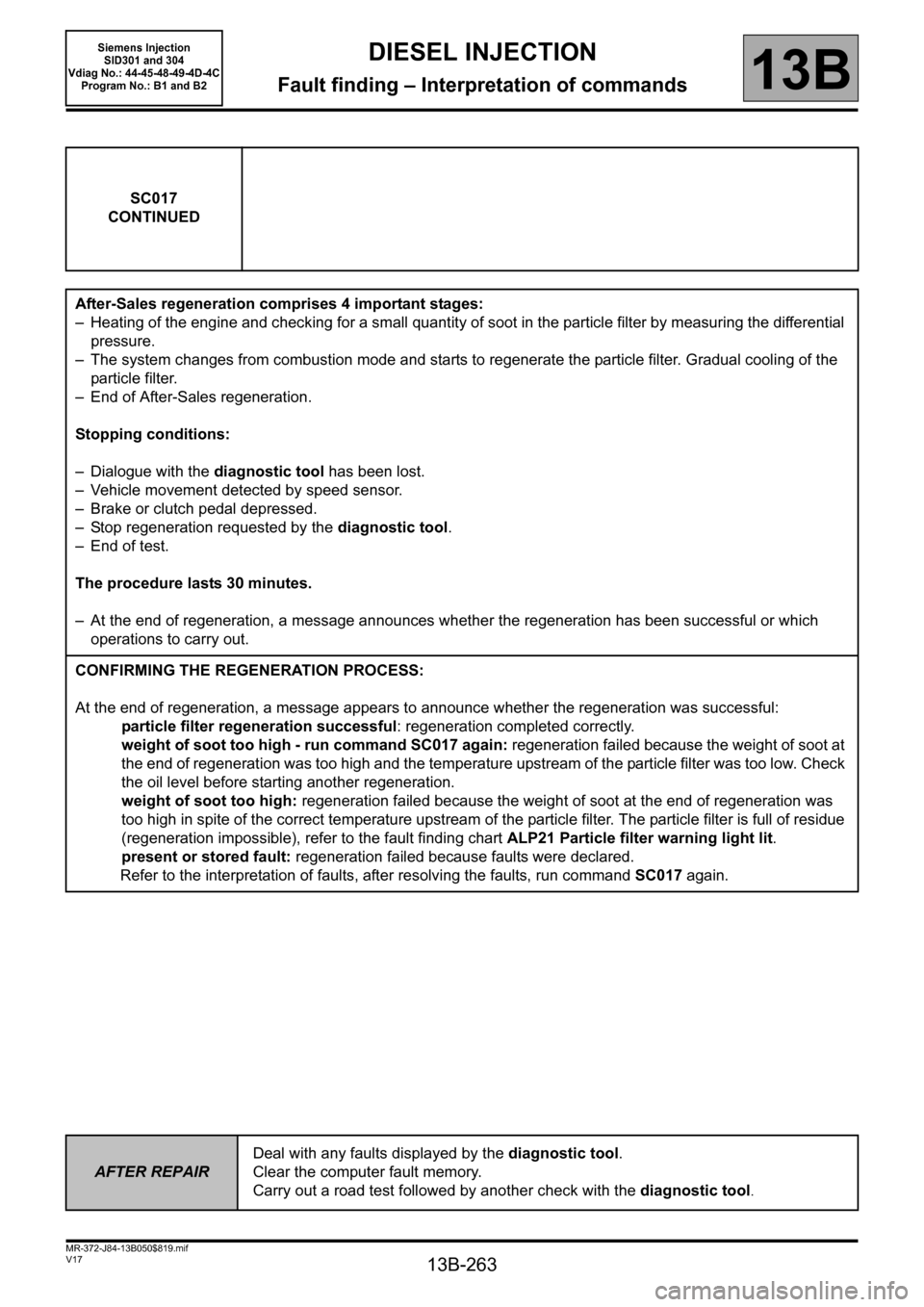oil change RENAULT SCENIC 2011 J95 / 3.G Engine And Peripherals Siemens Injection Workshop Manual
[x] Cancel search | Manufacturer: RENAULT, Model Year: 2011, Model line: SCENIC, Model: RENAULT SCENIC 2011 J95 / 3.GPages: 329, PDF Size: 1.71 MB
Page 19 of 329

13B-19
MR-372-J84-13B050$195.mif
V17
Siemens Injection
SID301 and 304
Vdiag No.: 44-45-48-49-4D-4C
Program No.: B1 and B2DIESEL INJECTION
Fault finding – Function13B
INTERSYSTEM EXCHANGES
The inter-system connections concerning the particular requirements of engine management are as follows:
●Request for injection computer to switch on the OBD warning light to warn of an OBD related pollution fault.
●Request to switch on the Level 1 warning light to warn of an operational safety fault with the engine
management system which may restrict performance.
●Request to switch on the Level 2 warning light to warn of an operational safety fault with the engine
management system which may result in the engine stopping.
●Request to switch on the Particle Filter and Service warning light to warn of an operational safety fault of the
particle filter system which may result in reduced performance or engine stoppage.
●Request to switch on the Engine overheating warning light to warn of an engine overheating fault or a fault
in the coolant temperature sensor.
●Request to switch on the Particle filter warning light to warn the driver that the particle filter is loaded with
particles (weight of soot more than 30.8 g). As soon as possible, the driver must drive at a speed of more than
25 mph (40 km/h) for 2 minutes to activate regeneration.
The driver must maintain a speed of more than 25 mph (40 km/h) until the particle filter warning light goes out
(Vdiag 45 and 49 only).
●Request to start the fan assembly for engine cooling and also for air conditioning purposes,
●Request to switch off the air conditioning compressor for engine programming requirements such as pulling
away, performance, anti-stalling, overspeed, etc.
●Request to switch off electrical consumers (passenger compartment heating resistor (if fitted), heated rear
screen, etc.) for engine operation purposes such as: pulling away, performance, anti-stalling,
overspeed, etc.
●Formulation of requests to engage electrical consumers and limit power as a function of rail conditions.
This last function is made possible with the introduction of alternator control. Formulation of requests enables
the smooth running of the engine to be improved in the critical operating phases, mainly at idle speed and
when pulling away. These requests pass via the multiplex network to the Protection and Switching Unit where
they are converted before being sent to the alternator.
In comparison to the version without a particle filter (K9K Step 2), the K9K Step 2 particle filter technical
specifications also include:
●Four temperature sensors spread along the exhaust system.
●One differential pressure sensor.
●One fuel injector with a dedicated electric fuel pump.
●An electric water pump (in addition to the mechanical pump) controlled by a relay to cool the turbocharger when
the engine is stopped (only for Clio III, Modus and Mégane II/Scénic II).
●Four heating elements and their control unit.
Oil Control System (OCS) (except Vdiag 44, 45 and 49)
This program takes into account the driving style of the user to warn him of the need for an oil change. This program
counts the number of miles since the last oil change, corrected by a factor which depends on the oil temperature.
When the number of miles exceeds a threshold, the customer is warned by a message to the instrument panel that
the drain must be performed.
After the oil change, the user must reset the oil change interval on the instrument panel.
Page 27 of 329

13B-27
MR-372-J84-13B050$273.mif
V17
Siemens Injection
SID301 and 304
Vdiag No.: 44-45-48-49-4D-4C
Program No.: B1 and B2DIESEL INJECTION
Fault finding – Replacement of components13B
If no communication is possible with the injection computer during reprogramming or programming:
●Clear the programming using command RZ019 Reinitialise programming.
●Clear any faults using command RZ001 Fault memory.
●Enter the V.I.N. using command SC013 Enter VIN code.
●Perform a powerlatch.
●Perform a detection of the cruise control - speed limiter and the air conditioning:
– Vehicle ignition on.
– Main switch in rest position (the computer then detects the rest position).
– Switch in Cruise control position to activate the Cruise control function.
– Switch in Speed limiter position to activate the Speed limiter function.
– Air conditioning in the ON position.
●For Kangoo II, program the values for fast idle speed (if equipped) and vehicle speed restriction (if equipped)
using commands SC041 Modification of commercial vehicle idle speed and SC040 Speed limiter.
●For Vdiag 45, 49 and 4D, carry out a particle filter regeneration using command SC017 Particle filter
regeneration (see Interpretation of commands).
●For Clio III, Modus, Megane II and Scenic II vehicles:
– If the configuration reading LC106 O.C.S. is" WITH" (check in the instrument panel computer), perform
an engine oil change and initialise the value of the oil service interval using the instrument panel.
●For Kangoo II:
– Change the engine oil and initialise the value of the oil change interval using the instrument panel.
IMPORTANT
The injection computer retains the immobiliser code for life.
The system has no security code.
It is forbidden to perform tests with computers borrowed from the Parts Department or from another vehicle
which must then be returned.
These computers are hard-coded.
If the injection computer is faulty, contact the Techline (and refer to the fault finding log).
Page 93 of 329

13B-93
MR-372-J84-13B050$429.mif
V17
DIESEL INJECTION
Fault finding – Interpretation of faults
Siemens Injection
SID301 and 304
Vdiag No.: 44-45-48-49-4D-4C
Program No.: B1 and B2
13B
DF648
PRESENT
OR
STOREDCOMPUTER
1. DEF: Configuration/Initialisation
NOTESSpecial note:
–The level 1 fault warning light is lit on the instrument panel.
Clear the fault memory using command RZ001 Fault memory.
Change the engine oil and initialise the value of the oil service interval using the instrument panel.
Switch off the ignition, wait for the end of the power latch, then start the vehicle.
Switch off the ignition again, wait for the end of the power latch, then switch the ignition back on.
If the fault is still present, contact the Techline.
AFTER REPAIRDeal with any faults displayed by the diagnostic tool.
Clear the computer fault memory.
Carry out a road test followed by another check with the diagnostic tool.
SID301_V44_DF648 / SID304_V45_DF648 / SID301_V48_DF648 / SID304_V49_DF648 / SID304_V4D_DF648 / SID301_V4C_DF648
Page 224 of 329

13B-224
MR-372-J84-13B050$741.mif
V17
DIESEL INJECTION
Fault finding – Interpretation of parameters
Siemens Injection
SID301 and 304
Vdiag No.: 44-45-48-49-4D-4C
Program No.: B1 and B2
13B
PR132
AIR FLOW
PARAMETER
DEFINITIONThis parameter indicates the inlet air flow in mg/st.
NOTESSpecial notes:
Only perform these tests if the parameters do not correspond with the system
operation programming.
No faults must be present.
Perform this fault finding procedure:
– after finding an inconsistency in the parameter,
– or after a customer complaint (lack of power, smoke etc.).
Use CLIO III, MODUS, MEGANE II ph2, SCENIC II ph2 and KANGOO II Wiring
Diagrams Technical Notes.
Sensor electrical conformity
Check the air inlet circuit (from the air filter inlet to the inlet manifold, run test 10 Air line at the turbocharger):
– air filter unit inlet not blocked and filter not clogged,
–visual inspection only, use ALP2 The engine does not start or starts with difficulty,
– oil vapour recirculation circuit connected correctly,
–absence of leaks or blockages in the low and high pressure air circuits: ducts, presence and tightness
of the mounting clips, mounting of the turbocharging pressure sensor, exchanger, etc.
– check that the damper valve is not jammed shut (except Vdiag 4C).
Carry out the necessary repairs.
Check the electrical conformity of the air flow sensor:
Check the + 5 V supply to the air flowmeter.
– connection 3KJ of component 799.
AFTER REPAIRDeal with any faults displayed by the diagnostic tool.
Clear the computer memory.
Carry out a road test followed by another check with the diagnostic tool.
SID301_V44_PR132 / SID304_V45_PR132 / SID301_V48_PR132 / SID304_V49_PR132 / SID304_V4D_PR132 / SID301_V4C_PR132
Page 253 of 329

13B-253
MR-372-J84-13B050$780.mif
V17
DIESEL INJECTION
Fault finding – Interpretation of parameters
Siemens Injection
SID301 and 304
Vdiag No.: 44-45-48-49-4D-4C
Program No.: B1 and B2
13B
PR873
OIL OXIDATION SIGNAL
PARAMETER
DEFINITIONThis parameter indicates the vehicle mileage when the oil oxidation threshold is
reached.
NOTESOnly apply the interpretation of this parameter if the OCS (oil control system)
program is activated on the instrument panel. Check on the instrument panel computer
that the configuration reading LC106 O.C.S. is set to WITH.
Except Vdiag 44, 45 and 49.
Conformity check: Engine stopped and the ignition on, or the engine running and the engine coolant
temperature > 80°C, without electrical consumers
The oil status is calculated by the oxidation program in the injection computer, depending on the engine revs.
When this count reaches a certain threshold before the end of the oil change period, the injection computer sends
a signal to the instrument panel, which will display "service required soon". PR873 corresponds to the vehicle
distance at the time this signal is sent.
The instrument panel computer counts down 900 miles (1500 km) before displaying the message "service
required".
IMPORTANT
When the message "service required" appears on the instrument panel, the customer must arrange an oil
service within the remaining 900 miles (1500 km).
AFTER REPAIRDeal with any faults displayed by the diagnostic tool.
Clear the computer memory.
Carry out a road test followed by another check with the diagnostic tool.
SID301_V44_PR873/SID301_V45_PR873/SID304_V49_PR873
Page 255 of 329

13B-255
MR-372-J84-13B050$780.mif
V17
DIESEL INJECTION
Fault finding – Interpretation of parameters
Siemens Injection
SID301 and 304
Vdiag No.: 44-45-48-49-4D-4C
Program No.: B1 and B2
13B
PR875
OIL DILUTION SIGNAL
PARAMETER
DEFINITIONThis parameter indicates the vehicle mileage when the oil dilution threshold is reached.
NOTESThis parameter should be interpreted only if the OCS (Oil Control System) program
is activated on the instrument panel. On the instrument panel computer, check the
configuration reading LC106 O.C.S: WITH.
Except Vdiag 44, 45 and 49.
Conformity check: Engine stopped and the ignition on, or the engine running and the engine coolant
temperature > 80°C, without electrical consumers
The injection computer assesses the dilution rate of the engine oil according to the customer's driving style.
When the dilution level reaches a certain threshold before the end of the oil change interval, the injection
computer sends a signal to the instrument panel, which then displays Service required. Parameter PR875
corresponds to the vehicle mileage at the time this signal is sent.
IMPORTANT
When the message Service required appears on the instrument panel, the customer must arrange an immediate
oil change to prevent damage to the engine.
AFTER REPAIRDeal with any faults displayed by the diagnostic tool.
Clear the computer memory.
Carry out a road test followed by another check with the diagnostic tool.
SID301_V44_PR875/SID304_V45_PR875/SID301_V4C_PR875
Page 263 of 329

13B-263
MR-372-J84-13B050$819.mif
V17
DIESEL INJECTION
Fault finding – Interpretation of commands
Siemens Injection
SID301 and 304
Vdiag No.: 44-45-48-49-4D-4C
Program No.: B1 and B2
13B
SC017
CONTINUED
After-Sales regeneration comprises 4 important stages:
– Heating of the engine and checking for a small quantity of soot in the particle filter by measuring the differential
pressure.
– The system changes from combustion mode and starts to regenerate the particle filter. Gradual cooling of the
particle filter.
– End of After-Sales regeneration.
Stopping conditions:
– Dialogue with the diagnostic tool has been lost.
– Vehicle movement detected by speed sensor.
– Brake or clutch pedal depressed.
– Stop regeneration requested by the diagnostic tool.
– End of test.
The procedure lasts 30 minutes.
– At the end of regeneration, a message announces whether the regeneration has been successful or which
operations to carry out.
CONFIRMING THE REGENERATION PROCESS:
At the end of regeneration, a message appears to announce whether the regeneration was successful:
particle filter regeneration successful: regeneration completed correctly.
weight of soot too high - run command SC017 again: regeneration failed because the weight of soot at
the end of regeneration was too high and the temperature upstream of the particle filter was too low. Check
the oil level before starting another regeneration.
weight of soot too high: regeneration failed because the weight of soot at the end of regeneration was
too high in spite of the correct temperature upstream of the particle filter. The particle filter is full of residue
(regeneration impossible), refer to the fault finding chart ALP21 Particle filter warning light lit.
present or stored fault: regeneration failed because faults were declared.
Refer to the interpretation of faults, after resolving the faults, run command SC017 again.
AFTER REPAIRDeal with any faults displayed by the diagnostic tool.
Clear the computer fault memory.
Carry out a road test followed by another check with the diagnostic tool
.
Page 323 of 329

13B-323
MR-372-J84-13B050$936.mif
V17
DIESEL INJECTION
Fault finding – Tests
Siemens Injection
SID301 and 304
Vdiag No.: 44-45-48-49-4D-4C
Program No.: B1 and B2
13B
TEST 9
CONTINUED 2
PA R T B
1 - NO particle filter regeneration.
2 - Write on the repair order: the parameter and status relating to the last failure:
– Mileage of last Particle filter warning light record
– Mileage of last Failed regeneration records
– Engine statuses for last Engine status records
Example: PR837 = 2794 miles (4657 km); PR801 = 2760 miles (4600 km); engine status = STOPPED
3 - Interpretation of the values written on the repair order by the service advisor for the customer:
Before the last time the warning light or Particle Filter message came on (appeared at the mileage of the last
Stored particle filter warning light) the customer did not follow the driving instructions: the failure which
occurred at the Mileage of the last failure was due to the engine being switched off.
4 - Service advisor explains to the customer the procedure to turn off the warning light, backed up by the
parameters written in the repair order: see PA R T D.
PA R T C
1 - Carry out a regeneration in the Renault dealership with the approval of the Techline.
Follow the procedure for command SC017 Particle filter regeneration.
Note: Do not carry out an engine oil change following an After-Sales regeneration.
2 - Explain the procedure for regeneration while driving to the customer to reduce returns to the garage:
see SECTION D:
AFTER REPAIRCarry out a road test followed by a complete check with the diagnostic tool.